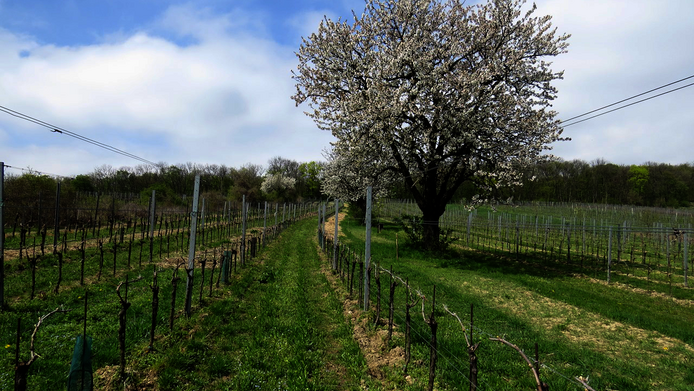More life between vine rows

Whether it's at a wine festival, an open-day at a wine cellar or during the direct marketing of wine from the producer: wherever winegrowers have on-site, first-hand contact with consumers, they appreciate the boost to their image and economic success provided by the scenic beauty of the landscape. “When asked which benefits of the vineyard ecosystem are most important for them, many winegrowers indeed ranked landscape aesthetics in third place. Regarding the consequences of climate change, such as more frequent heavy rainfalls, they also consider the prevention of soil erosion and the preservation of soil fertility to be among the top issues,” reports Silvia Winter, an agricultural ecologist at the Department of Crop Sciences at the University of Natural Resources and Life Sciences Vienna. Winter is the principal investigator of a transnational research project funded by the FWF. Within this project, a Master student interviewed around 700 locals, tourists and winegrowers in the Austrian wine-growing region of “Neusiedlersee-Hügelland”.
From West to East
These surveys of landscape aesthetics, and above all the recording and analysis of biodiversity in vineyards, aimed at analysing how different soil management types in the “inter-rows” – the area between the vine rows – affect the biodiversity in the vineyard and its susceptibility to erosion. In order to study the interaction under different climatic conditions and soil types, the researchers also investigated about 16 vineyards per country with varying types of tillage in Spain, France, Austria and Romania. The differences relate primarily to the intensity of tilling, ranging from frequent tilling or “bare ground” to alternating vegetation cover (every second row) and permanent vegetation cover. Not in every country all intensity levels were studied. In the Spanish wine-growing region “Montilla Moriles” and in the Romanian “Târnava” area, bare ground, i.e. intensive cultivation, were frequently found. In the Austrian “Carnuntum” and “Neusiedlersee-Hügelland” regions, the team found mainly permanent and alternating vegetation cover, which is primarily a result of many years of agri-environmental policy measures. The French “Val de Loire” was the only region where herbicides instead of tillage was used in the bare ground inter-row management.
Significant differences in biodiversity
In order to understand the interaction of soil cultivation, climate and landscape structure and the resulting consequences for biodiversity and the susceptibility to soil erosion, the researchers collected comprehensive data on inter-row vegetation, soil organisms, wild bees and soil parameters. Together with colleagues from the Department of Integrative Biology and Biodiversity Research, Winter explored, for instance, the variety of plant species growing in vineyards, the vegetation cover and the species diversity and abundance of wild bees, earthworms and springtails. Peter Strauss, Head of the Institute for Land and Water Management Research at the Austrian Federal Agency for Water Management, conducted the soil investigations, looking at aspects such as aggregate stability. “More stable and larger soil aggregates help to reduce soil erosion and improve water infiltration, which is particularly important during heavy rainfall events,” Winter explains. This is why soil properties are so important for determining susceptibility to erosion. As far as biodiversity is concerned, the Europe-wide comparison uncovered clear differences, especially relating to wild bees and earthworms. The study revealed that the intensively cultivated, hot and dry Spanish wine-growing region was especially species-poor. The team counted few wild bees and almost no earthworms there. “The high number of zero results per soil sample was actually shocking,” says Winter. In contrast, the humid Atlantic climate, together with less frequent tillage in French vineyards, had a particularly positive effect on the earthworm population there, with twenty or more individuals identified per sample.
Recalculating susceptibility to soil erosion
Based on management, soil and climate data, a model is used to calculate the erosion risk for a given area. The “cover-management factor”, C-factor in short, is a central parameter because it determines the mitigating effect of vegetation on erosion. This standardised value depends on land use and is applied throughout Europe. “According to our research results, the susceptibility to erosion is strongly dependent on how often the soil is cultivated. This is why the C-factor for viticulture must be considered in a differentiated way,” suggests Peter Strauss from the Austrian Federal Agency for Water Management. In Austria, where alternating and permanent vegetation cover are predominant, the C-factor needs to be downgraded as the soil erosion risk is lower than expected. The project’s country comparison shows that the Austrian practice of greening the inter-rows with seed mixtures is unique – however, in order to preserve biodiversity, Winter notes that “the amount of flowering plants must be increased instead of just paying attention to a high degree of ground cover.” Flowering plants not only attract wild bees, they also represent an important resource for the survival of this extremely diverse species group in the monotonous agricultural landscape. In comparative terms, however, the Austrian wine-growing landscapes turned out to be very structurally diverse. If vineyard inter-rows are carefully managed and their potential as habitats for plants and animals is actively supported, they provide a significant contribution to fostering ecosystem services such as erosion control.
Personal details Silvia Winter studied agricultural sciences and bioinformatics. She is an agricultural ecologist and is a researcher at the University of Natural Resources and Life Sciences Vienna. In early 2019, Winter launched another international FWF project Scenarios for providing multiple ecosystem services and biodiversity in viticultural landscapes.
Publications





